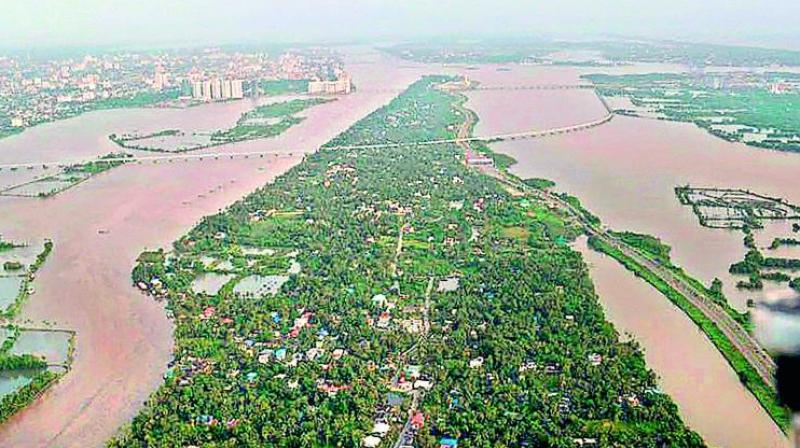Shobhaa's Take: So much to learn from God's own country'

Subramaniam has been with our family for close to 40 years. I exaggerate not when I say he is the best chauffeur I have ever come across anywhere in the world. Above all, he is a fine human being — proud, sensitive, aware and intelligent. He left his hometown near Kottayam more than four decades ago to make Mumbai his home. And yet, Mumbai never really became his true home. His heart yearns for Kerala, every waking hour. He dreams of Kerala. He breathes Kerala. Even after he married a Mangalorean lady 30 years ago, he determinedly stuck to his Kerala roots, be it the food cooked in their suburban kitchen or his attire over weekends. When the floods struck Kerala with the sort of fury the state has not experienced before, I expected Subramaniam to be most agitated and ask for leave to go home and help his extended family. But no. Subramaniam was calm and confident through the worst period. How come? He had unshakeable faith in his people. He was certain Kerala would pull through somehow. It did! And how.
A lot has been written about how brilliantly the devastated state coped with the catastrophe. The individual stories of valour and sacrifice are known to all. But it was the bigger, coordinated effort involving agencies and ordinary citizens, the police and politicians, the armed forces and fishermen — these are the true heroes of what could have been an even bigger tragedy. A Malayalee friend of ours showed us videos of his beautiful riverside home, with water levels entering all the rooms and destroying his carefully tended garden estate, reducing everything to a gigantic lake. He had a crooked smile on his face while sharing the visuals, one of which showed his 83-year-old aunt being saved by volunteers, who are seen gently lifting the old lady into a boat. In his place I would have been hysterical and upset, worried and overwrought. His composure was admirable. I joked, “What’s with you people from Kerala? Tell us what you eat… maybe I need to change my diet.” He shrugged philosophically and talked most positively about the monumental initiatives that had kicked into place rapidly, to mobilise support and assistance to even the most inaccessible of places. How did Kerala do it? What can we learn from Kerala about crisis management? Here in Mumbai, we can barely survive the monsoons. Our potholes have made international news. Our clogged drains have become an annual nightmare. Despite all the early warnings and the predictability of weather forecasts, Mumbai is always caught on the wrong foot. It’s a wonder we don’t suffer more fatalities and house crashes, given the precarious state of infrastructure, in what used to be India’s richest, most modern metropolis.
Kerala proved to the watching world what it is capable of during disasters like floods on such an intense scale. It was great to watch a couple of state ministers working shoulder to shoulder with volunteers, making sure supplies were swiftly dispatched to the needy. This is what we vote leaders into power for! To serve the people and set the pace during crises. For years, it was considered sufficient for top politicians to undertake aerial surveys during calamities, accompanied by the media, of course. Those meaningless surveys did nothing at all for the affected people, and were mere photo ops for netas trying to show “we care”! Today’s voter cannot be this easily fooled. The worst hit people of Kerala were quick to acknowledge the commendable rescue work undertaken by their government. No doubt there were several glitches, and fake news added to the confusion. But even here, alert social media watchdogs were quick to call out people like “Suresh” for what he is — an unscrupulous political stooge for a right-wing organisation, cold-bloodedly spreading disinformation, while blatantly asking for donations to be sent to his outfit.
Such was the level of public concern and engagement, most high-profile celebrities contributed generously to the Chief Minister’s Distress Relief Fund (CMDRF), investing trust and belief in the genuineness of these efforts. As always, prominent Bollywood stars pitched in and showed the way by cutting fat cheques to the CM’s office, while encouraging their colleagues and fans to follow suit. Perhaps, the only discordant note was struck by Congressman Shashi Tharoor, overstepping as usual and claiming he’d been authorised by the Kerala CM to seek funds from the UN while he himself was in Geneva to attend Kofi Annan’s funeral. The CM didn’t waste time issuing a statement denying any such “request” made by him to Mr Tharoor. However, the CM and his overenthusiastic team goofed up when they grandly announced a Rs 700-crore relief package from the UAE.
The other sour note was left when avaricious airlines like Jet Airways and SpiceJet allegedly hiked up tariffs from Thiruvananthapuram airport to Delhi, to nearly Rs 90K for a one-way ticket! This was exploitative and shameless in the extreme. The right thing to do would have been to drastically reduce fares. Such poor PR takes a toll in the long run.
Post-mortems are never pretty. Today, there are serious charges pointing out lapses that may have led to the unprecedented flooding (unauthorised opening up of 44 dams, for example). Combine that with unplanned construction by unscrupulous, avaricious builders, and what you get is a monumental disaster.
While Kerala builds itself back, it’s a good idea for other states to re-examine policies and be far more stringent before granting permissions to dodgy builders eager to exploit loopholes in the system. It’s time to stop these sharks from “developing” tracts of forestland, diverting rivers and carving out hills for housing. We cannot afford another Kerala catastrophe.
H09

